Analysis of Soil Quality Using Physico-Chemical Parameters with Special Emphasis on Fluoride from Selected Sites of Sawai Madhopur Tehsil, Rajasthan - Juniper Publishers
Juniper Publishers-Open Access Journal of Environmental Sciences & Natural Resources
Analysis of Soil Quality Using Physico-Chemical Parameters with Special Emphasis on Fluoride from Selected Sites of Sawai Madhopur Tehsil, Rajasthan
Authored by Arshi Iram
Abstract
Soil samples from were collected for analysis from the agricultural fields of Sawai Madhopur tehsil. Inhabitants, cattle and some crop species which are sensitive to fluoride toxicity of this tehsil suffer from fluorosis. Soil samples were collected from 35 villages of Sawai Madhopur Tehsil. Total 175 samples (5 samples from each village) were analyzed. Selected ion meter was used for estimation of fluoride. Fluoride ion concentration in soil samples varied from 1.0ppm to 8.23ppm. Out of 35villages 1village is in 0-1ppm, 7 villages is in 1-1.5ppm, 7 villages is in 1.5-2.5ppm ,16 villages is in 2.5- 5.0ppm and 4 villages is in 5.0-10.0ppm range .
Keywords: Fluoride; Physico-Chemical; Parameters; Subsoil Water
Introduction
Soil is a vital component, medium of unconsolidated nutrients and materials, forms the life layer of plants. Soil developed as a result of pedogenic processes through weathering of rocks, consisting of inorganic and organic constituents, possessing definite chemical, physical, mineralogical and biological properties, having variability from depth to surface of the earth, and provides a medium for plant growth Thakre [1]. Soil physic-chemical properties influence the behavior of soil and hence, knowledge of soil property is important Sumithra [2]. Soil testing is the only way to determine the available nutrient status in soil and the only way we can develop specific fertilizer recommendations. Soil properties that are sensitive to changes can be used as indicators to improve soil quality. Analysis of soil is carried out for the studies of various parameters like total Organic Carbon, Available Nitrogen (N), Phosphorus (P2O5) and Potassium [K2O], pH, Electrical conductivity, soil texture, bulk density, chloride, fluoride and % moisture content. The fertility of the soil depends on the concentration of N, P, K, organic and inorganic materials, conductivity. The physicochemical properties such as moisture content, Nitrogen, phosphorus and organic matter required for the growth of plant. Potassium is used for flowering purpose, it is also required for building of protein, photosynthesis, fruit quality and reduction of diseases and phosphate is used for growth of roots in plants.
Fluoride Distribution in Soil
The main source of fluoride in soil is Pegmatite Pneumatolitic deposits as vein deposit in rocks or Pegmatite & metamorphosed limestone, higher concentrations (1,000 g/kg) can occur in soils by anthropogenic inputs, such as phosphate fertilizers Kabata [3]. Mostly fluorine present as oxy-hydroxides, only a few parts dissolved in the soil solution. Fluoride mobility in soil soil’s sorption capacity is positively correlated, and sorption capacity depends on pH and soil salinity Cronin [4]. Fluoride contaminated soil are more acidic or alkaline, the risk of fluoride toxicity in shoots of plants would increase with increasing concentration of fluoride in soil Stevens [5]. Fluoride at high concentration in soils toxic not only for plants but also for grazing animals who feed in such soils Clark, O’Hara and Cordes, Cronin Loganathan.
Study Area
Sawai Madhopur district is located in the eastern part of the Rajasthan State, it lies between 250 45’ to 260 41 N latitude and 75059’ to 770 0’ E longitude. Administratively, the district is divided into 4 sub-divisions viz. Gangapur, Bamanwas, Bonli and Sawai Madhopur and has seven tehsils i.e. Gangapur, Bamanwas, Malarna Dungar, Bonli, Chouth Ka Barwara, Sawai Madhopur and Khandar. The total area of Sawai Madhopur tehsil is 5042.99 km2 with a population of about 1,20,998. Out of this 19.04 percent of total population lives in towns and 80.96 percent in rural area. The climate of the district can be classified as semi-humid. It is characterized by very hot summers and very cold winters with fairly good rainfall during south-west monsoon period. Many villages contain high fluoride concentrations (Figure 1).

Materials and Methods
Selection of Sampling Station
For the purpose of this study soil samples were collected from various agricultural fields of the area. In total 175 samples from 35 villages were collected. Five soil samples at 0-15 cm depth were collected randomly from each village.
Sampling Procedure
In order to collect soil samples (0-15 cm depth) first removed grasses, litter and other plant residues from soil surface and collect soil samples by using soil collection tools. In each case, a triangular block was marked and soil samples were collected in plastic bags, which were sealed, and labeled properly. Soil samples were brought to the laboratory for analysis. Before analysis, the samples were hot air dried and homogenized, sieved through a 2mm sieve to ensure homogeneity. The samples were preserved in clean sealed polythene bags for analysis (Table 1).
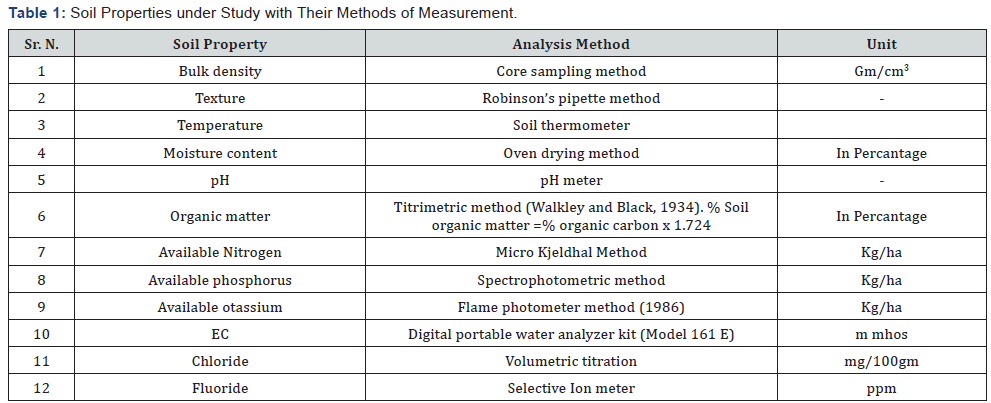
Soil Quality Parameters and Methodology
For analysis of physicochemical parameters of the soil samples first we prepared soil suspension in distilled water (1:4 w/v) and allowed to settle down the particles. Main focus was on those soil quality parameters which influence the movement and retention of water that contribute to store and supply of nutrients. In this study some selected physical and chemical parameters were determined.
Physical Parameters: Temperature, Texture, Bulk density, Moisture content.
Chemical Parameters: pH, Organic matter, Available Nitrogen, Available Phosphorus, Potassium, Electrical Conductivity, Chloride, Fluoride.
Fluoride Estimation: Fluoride estimated by ion selective meter (Mettler Toledo MA 235 pH /ion analyzer), Standard procedure was followed APHA [6] to get satisfactory results; total Ionic strength adjustment buffer (TISAB) was used to maintain a suitable ionic strength and also to avoid complex formation (Figure 2).
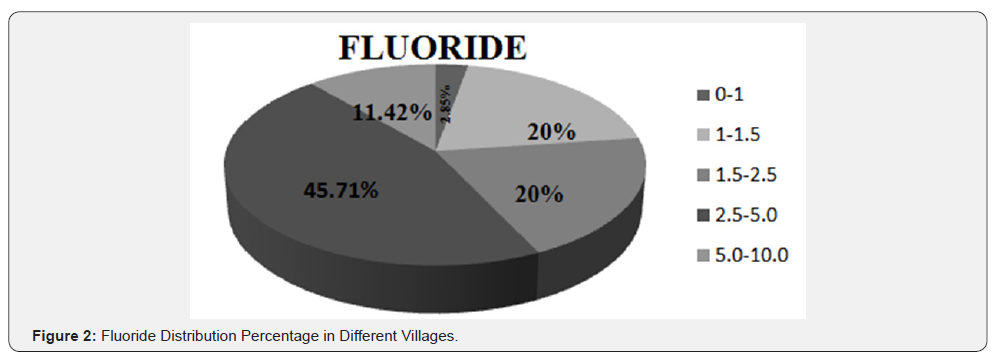
Statistical Analysis
In the present study Mean and Standard Deviation have been calculated for each pair of soil quality parameters by using Excel spreadsheet (Table 2). The standard formulae were used in the calculation for statistical parameters are as follows:
Mean(μ) = Σ X ÷ N
x = Value of Observation
N = Number of Observation
Standard Deviation =

x = Values of Parameter
n = Number of Observations
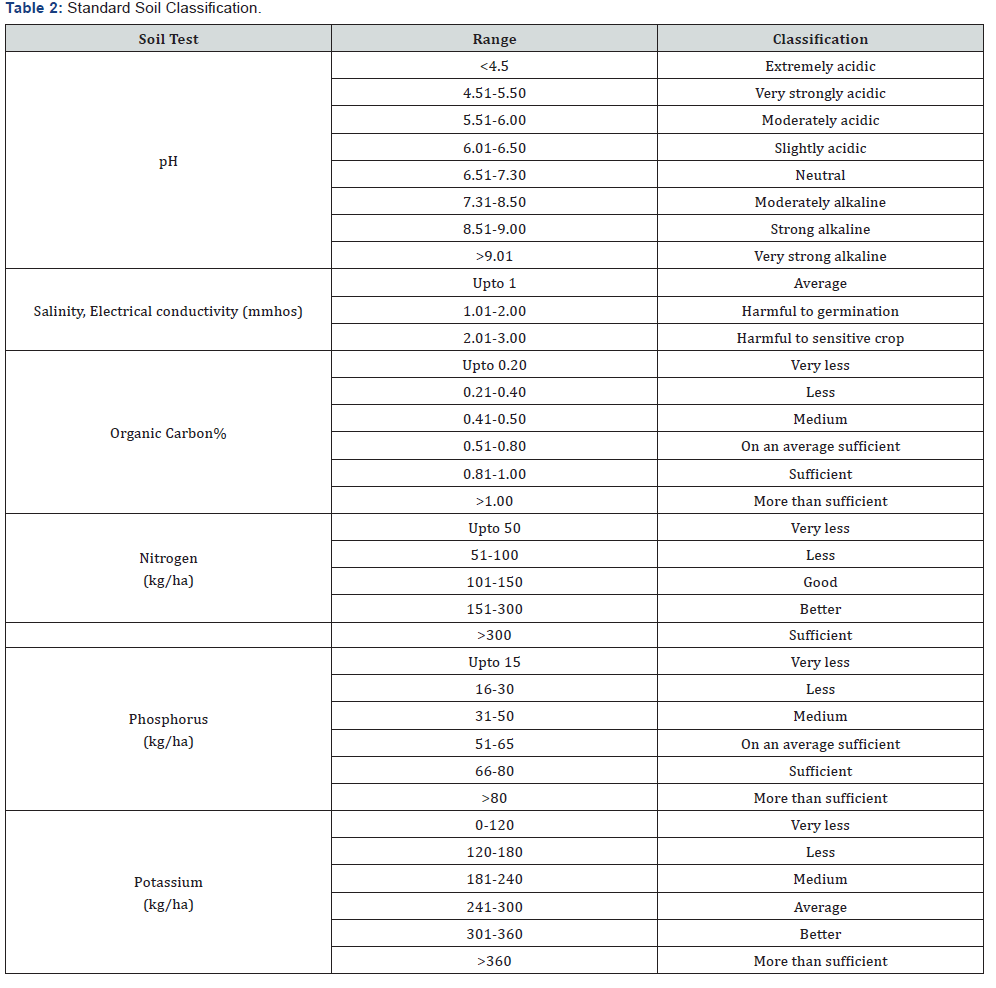
Result
The basic chemical and physical soil properties are given in Table 3. The analyzed chemical and physical properties show the wide variation range, as can be seen in the results. The pH of all soil samples were found to be ranged in between 7.04 to 8.3 which indicate the slight alkalinity of soils. Electrical conductivity of soil samples range between 0.026 to 1.967m mhos, in most of the samples except some hilly soil samples moisture content was in proportionate level between 7.02percent to 25.71 percent; moisture content varies in different season (Figure 3). Organic matter was varied widely among the various cultivated soils horizons selected for the study from 0.188 to 3.14percent. Chloride is generally mentioned as a hydrological and chemically inert substance. Chloride concentration in soil generally shows the salinity of soil, chloride concentration in soil samples ranged from 3.52 to 24.14mg/100gm. Most important factor which decide the soil productivity is N:P:K ratio. Available nitrogen found in soil samples between 13.8 to 218.60 kg/ha. Phosphorus considered as micro nutrient, is utilized by plant in the form of H2PO4- & HPO4-2 species. Appropriate concentration of phosphorus (P) is necessary for maintaining a balance between the other plant nutrients and ensuring the normal growth of the crop. Previous researches have already reported the importance of phosphorus Leonardi [7]. Available phosphorus ranged in cultivated soil samples of study area between 54.72 to 298.4kg/ ha.
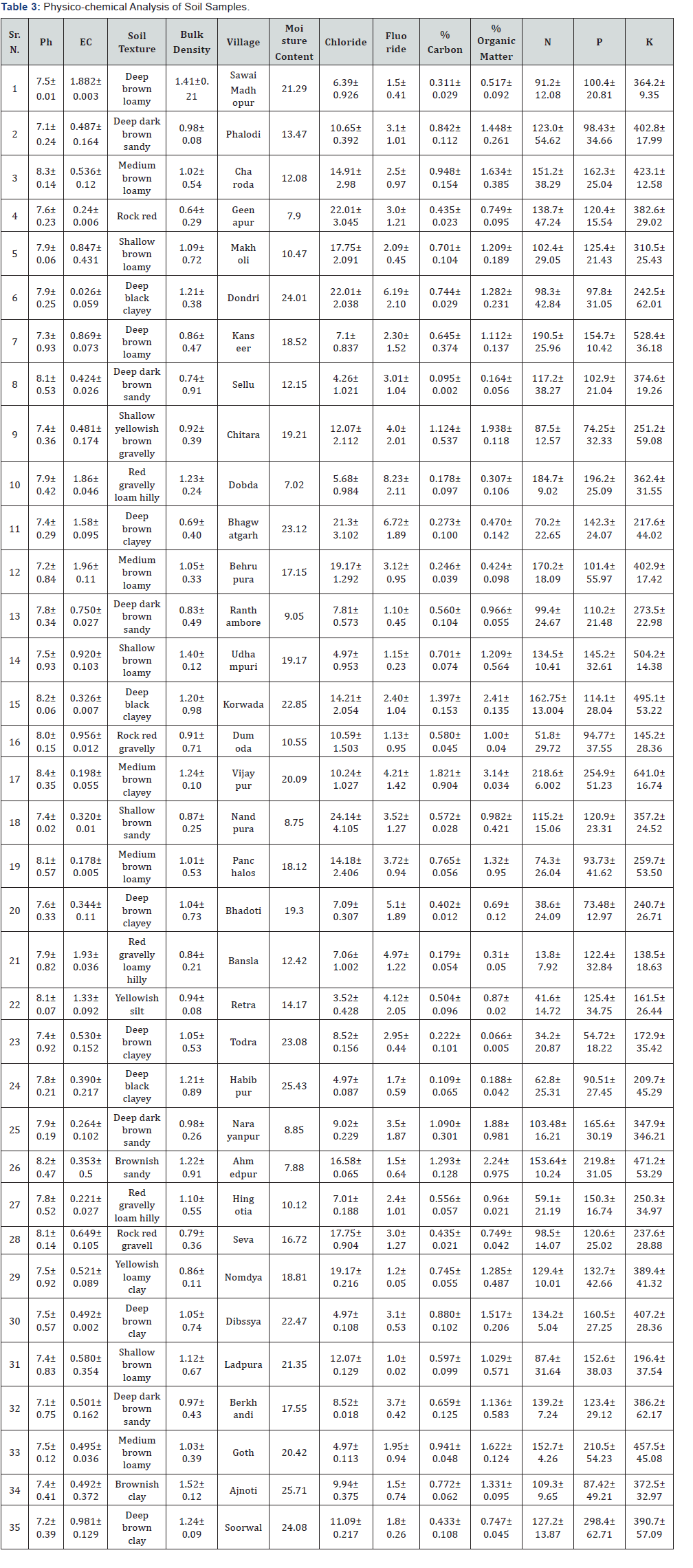
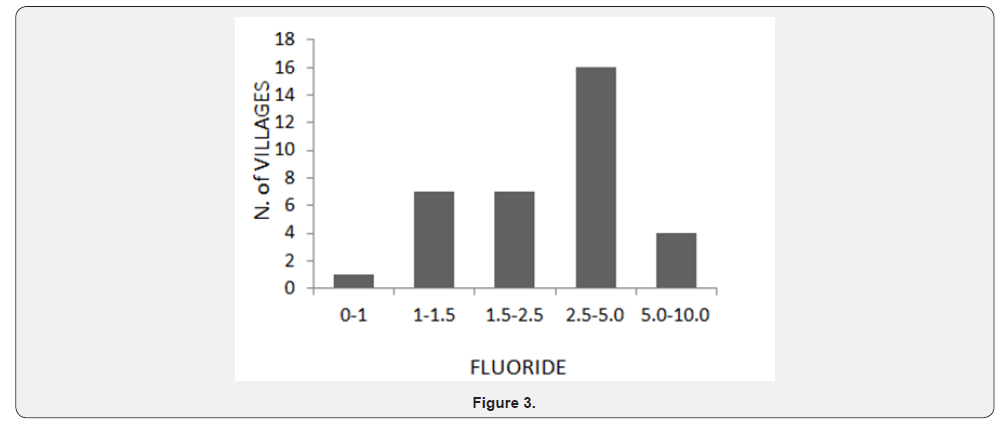
Generally, fluoride concentration in soil depends on the groundwater and rocks type in the area. Previous research explained this- The first reason is its inherent availability in the soil and the gaseous fluorine in the atmosphere. Fluoride is a mobile ion and its retention in the soil correlated with the amount and rate of water percolating into the soil zone which depends on the soil permeability. High permeability leads to high water content infiltration thus causing the ion to move deeper into the water table where it is retained. Fluoride can also be absorbed by some cations, radicals and oxides of metals to form complex compound. Fluoride levels were varied widely 1.0 to 8.23ppm among the various cultivated soils horizons selected for the study (Table 4).
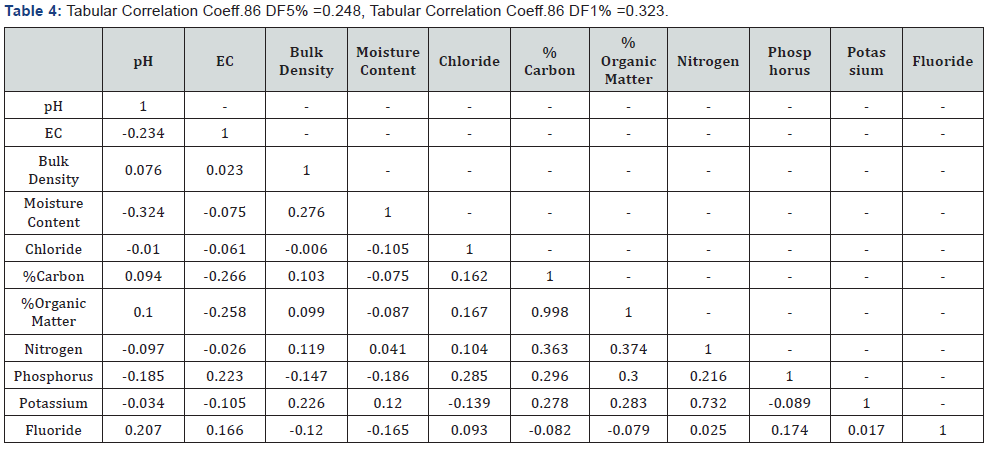
Discussion
pH can affect the availability of nutrients and activity of many essential micro-organisms, And most of the sample found alkaline, high alkalinity is not good for microbes. Several researchers showed that the texture of soil remain a major constraint to crop production. In this context, Nyabyenda [8] reported that the production of grain legumes had been low due to declining soil fertility as a result of soils impoverishment in organic matter content and corresponding texture. In present study variability in soil texture may contribute to the variation in nutrient storage and availability, water retention and transport and binding and stability of soil aggregates. As we can see black loamy soil has good N:P:K ratio. Soil texture directly or indirectly influences soil functions such as soil erosion, water availability Adhikari [9]. The sandy soil can quickly be recharged but its holding capacity is not good. As texture becomes heavier, the wilting point increases because fine soils with narrow pore spacing hold water more tightly than soils with wide pore spacing Thakre. In the present study most of the samples were loamy. The bulk density depends on compaction, consolidation of the soil but it is negatively correlated to the organic content. According to Micheni [10] the soil organic matter plays an important role in maintaining soil quality.
Everyday falling down of leaves may increase the soil organic carbon and thus the total organic matter. In the study area soil organic matter content varies from very less to more than sufficient and its directly influenced by soil texture and moisture content. Chloride is an undesirable content but it’s unavoidable, because it is a essential micronutrient for optimal growth. Both potassium and Chloride play the main role to neutralize the charges, and as the most important inorganic osmotic active substances in plant cells and tissues. The association of potassium and Chloride is related to the opening and closing of stomata Oberg [11], Talbott [12], Fixen PE [13]. In most of site soil samples potassium content was in average range. Potassium is known to affect cell division, cell permeability formation of carbohydrates, translocation of sugars, various enzyme actions and resistance of some plants to certain diseases Miller and Turk [14]. Soils are basically categorized on behalf of soil fertility and presence of micro nutrient. In present findings site soil is less nutrient so farmers use more fertilizers and phosphate fertilizer shows the positive correlation with the presence of fluoride content in soil.
Chemical-intensive practices in agricultural fields increasing fluoride contamination and other pollution problems of a magnitude that exceeds normal limits. Plants take up fluoride through fine hair rootlets from the soil. Plants absorb more fluoride from sandy than from clay soil. The most prominent factors that dictate the amount of F in most soils are the quantity of clay minerals, the soil pH and the concentrations of Ca and P in soils Abida [15]. Same results found in the study of Larsen and Widdowson [16], Perroilt and Chhabra [17], Omueti and Jones [18] high adsorption of fluoride by soil mineral components is at about pH 6 to 8 [19-33].
Conclusion
The results of the study reveal the values or percentages of physico-chemical parameter, physicochemical study of soil is important to agricultural chemists for plants growth and soil management. Fluoride is generally present in soils in the form of cryolite (Na3AlF6), flurapatite (Ca5 (PO4)3.F) and other phosphate rocks. The results of present study will help to identify the type and degree of soil related problems and to suggest appropriate reclamation measure, and also to find out suitability for growing crops. It will also help to study the soil genesis. On the basis of this study farmers can get a approx idea about the amount of which fertilizers and nutrients needed to soil for increase the percentage yield of crops.
To know more about Juniper Publishers please click on: https://juniperpublishers.com/manuscript-guidelines.php
For more articles in Open Access Journal of Environmental Sciences & Natural Resources please click on: https://juniperpublishers.com/ijesnr/index.php
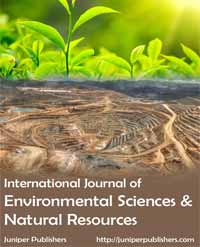


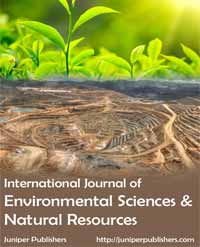
Comments
Post a Comment